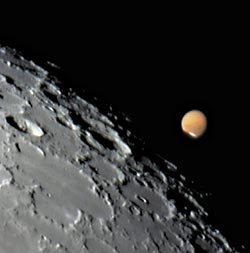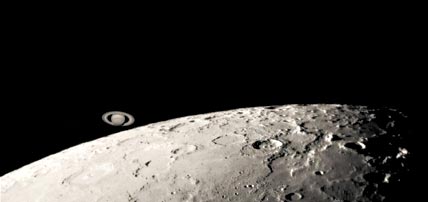
Mountains along the Moon's dark limb nick the south polar cap of Mars in this dramatic image taken last July 17th by Andrew Chaikin in central Florida. Mars is occulted twice in 2004, as this article explains, but its disk will be much smaller than the 19.6 arcseconds shown here. Click on the image to see a single-frame, time-lapse sequence of Mars grazing the lunar limb.
Courtesy Andrew Chaikin.
Sitting serenely at the eyepiece of a small telescope, you watch as the edge of the Moon creeps up on a star. The tiny point of light appears to touch the Moon’s limb for a few seconds — then, all of a sudden, it winks out! If you know just when and where to look, you can see the same star reappear, just as abruptly, on the Moon’s other side.
The Moon passing in front of a planet is a truly spellbinding event. The hiding and uncovering are gradual, and you can even see rugged lunar mountains silhouetted on the planet's disk.
The best of these occultations for the coming year are described here, so mark your calendar. It is especially satisfying to time them accurately, which is simpler than many skywatchers assume. You can make good timings by calling out an event to a tape recorder that is also recording time signals. Very accurate timings can often be made by just pointing a camcorder into the eyepiece of your telescope. Some stars are so bright that you can zoom in on the Moon with the camcorder directly — you don’t even need a telescope for these.
For a quarter century now, the International Occultation Timing Association (IOTA) has issued detailed predictions of the events visible throughout the world in each successive year. Our main focus is on those that can be seen from North America, Europe, Australia, and New Zealand, which are populated with many active observers. Only the brightest events can be mentioned, and many details (star's magnitude, lunar illumination, etc.) are not included in this Web article. The complete article appears in the January 2004 issue, page 102, and is available from Sky & Telescope's PDF archive. More detailed information for these and other areas is available via the Internet (see page 7).
Background Details

When the Moon passes in front of a bright star or planet, observers in some places on Earth (but not others) can see the light of the more distant body cut off. This map shows the year's best events worldwide (click on the image to see the complete chart); detailed maps later in this article give many more. A blue line denotes the northern limit of an occultation's visibility region, where the star will appear to graze the Moon's northern limb and perhaps blink off and on several times behind lunar mountaintops. A red line indicates an event's southern limit. Ticks are spaced 10 minutes apart, with the Universal Time shown on only a few of the ticks to avoid crowding. Time increases to the right. A circled A means the event is visible but the Moon’s altitude is too low for reliable timings, S means sunrise or sunset for bright objects or shows where twilight becomes too strong, and B marks where a central graze occurs at the Moon’s north or south cusp and terminates the path (unless the star is bright enough that it might be observed against the sunlit side of the Moon).
Sky & Telescope illustration.
In 2004 the Moon will cover Mars, Venus, and Jupiter, as well as many 2nd- to 4th-magnitude stars. It will occult numerous faint stars during two total lunar eclipses and will pass over open star clusters several times.
If the Moon is waxing, on its way to full, stars almost always disappear on the dark limb and are easy to watch. Reappearance happens on the bright limb, which overwhelms most stars with glare and makes them too hard to watch or time. When the Moon is waning, the events on the bright and dark limbs are reversed. In either case, a reappearance needs more care, since you have to be looking at the part of the Moon’s limb where the star will pop out.
For observers stationed within a mile or so (2 to 3 kilometers) of an occultation’s predicted northern or southern limit, a grazing occultation occurs. There you might see the star wink off and on several times as it passes behind hills and valleys near the Moon’s north or south pole. Observers spaced across this path will time different sequences of events, which can be analyzed to map the lunar-limb profile. Visual timings are fine for grazes, since their scientific value depends more on knowing each observer’s geographical location than on obtaining timings to better than, say, ½ second. Grazes are important for mapping the Moon’s apparently ice-rich polar regions, because the laser aboard the US Naval Research Laboratory’s Clementine spacecraft, which mapped the Moon from lunar orbit in 1994, did not reach those areas.
The year’s best grazes are shown on the maps in this article. Many total occultations require a small telescope. But a camcorder alone, or firmly mounted binoculars, might suffice for those involving bright stars. Grazes are the most dynamic, interesting, and valuable kind of lunar occultation.
Occultations of Bright Stars for North America in 2004

An occultation can be seen south of a blue line or north of a red line; tick marks at 10-minute intervals (increasing west to east) indicate the Universal Time of the middle of the graze. A circled A means the event is visible but the Moon’s altitude is too low for reliable timings, S means sunrise or sunset for bright objects or shows where twilight becomes too strong, and B marks where a central graze occurs at the Moon’s north or south cusp and terminates the path (unless the star is bright enough that it might be observed against the sunlit side of the Moon).
Sky & Telescope illustration.
Occultations of Bright Stars for Europe in 2004

An occultation can be seen south of a blue line or north of a red line; tick marks at 10-minute intervals (increasing west to east) indicate the Universal Time of the middle of the graze. A circled A means the event is visible but the Moon’s altitude is too low for reliable timings, S means sunrise or sunset for bright objects or shows where twilight becomes too strong, and B marks where a central graze occurs at the Moon’s north or south cusp and terminates the path (unless the star is bright enough that it might be observed against the sunlit side of the Moon).
Sky & Telescope illustration.
Occultations of Bright Stars for Australia and New Zealand in 2004

An occultation can be seen south of a blue line or north of a red line; tick marks at 10-minute intervals (increasing west to east) indicate the Universal Time of the middle of the graze. A circled A means the event is visible but the Moon’s altitude is too low for reliable timings, S means sunrise or sunset for bright objects or shows where twilight becomes too strong, and B marks where a central graze occurs at the Moon’s north or south cusp and terminates the path (unless the star is bright enough that it might be observed against the sunlit side of the Moon).
Sky & Telescope illustration.
Special Events for 2004

In Bend, Oregon, Craig Zerbe caught Saturn about to be hidden by the last-quarter Moon on September 10, 2001. Using an 11-inch Celestron telescope and Astrovid 2000 video camera, he created this mosaic from 21 individual frames.
Planets. The three brightest major planets will be occulted in 2004. There is probably little new that can be learned from these events in this age of space exploration, but they are still interesting to watch. In the case of Venus, the controversial “ashen light” that some observers have reported on the planet’s dark side might be observed briefly during a lunar occultation. But a night sky would be required, and both of this year’s Venus occultations take place in daytime or bright twilight except in narrow regions of central Asia, where few observers live. (The planet is mostly sunlit on November 10th, further hampering such an attempt.)
The year’s best occultation for most of North America will be the one of Jupiter by a crescent Moon, early on the morning of December 7th. Binoculars will probably be needed to see Jupiter slip behind the bright limb, but the reappearance at the Moon’s dark limb, lasting a half minute or more, will be a spectacular naked-eye sight. Jupiter’s faint ring might even be glimpsed with large telescopes just before the planet’s globe starts to emerge. An interesting dark-limb graze will be visible from the roughly 30-mile-wide southern partial-occultation zone, which passes near Big Bend and San Antonio, Texas, and near Key West, Florida.
To anticipate the Moon’s brightness and whether a planet will enter or leave at the dark limb, the lunar phase in the table below is listed as the percentage of the Moon’s disk that is sunlit, followed by “+” for waxing phases and “–” for waning phases.
| Occultations of Solar-System Objects, 2004 | ||||||
| Date | UT (h) | Planet | Mag. | Diameter | Moon (%) | Area of Visibility |
| Mar. 25 | 22 | Mars | 1.5 | 5.0" | 23+ | N N. America, Iceland |
| May 21 | 12 | Venus | –3.9 | 49.8" | 5+ | Europe, NW Africa, W Asia |
| June 9 | 22 | Vesta | 7.5 | 0.36" | 49– | NW Asia |
| Nov. 9 | 17 | Jupiter | –1.3 | 31.8" | 11– | N & E N. America |
| Nov. 10 | 2 | Venus | –4.0 | 12.9" | 8– | S Asia, Australia, N.Z. |
| Nov. 11 | 4 | Mars | 1.7 | 3.7" | 3– | E Africa, S Australia, N.Z. |
| Dec. 7 | 11 | Jupiter | –1.4 | 33.6" | 26– | N. America, W Africa |
Lunar eclipses. During a total eclipse of the Moon, occultations of 8th-magnitude stars are easy to time. Even stars of 9th and 10th magnitude can be seen against the lunar limb except while it is crossing the brightest outer parts of the umbra (Earth’s shadow core). The May 4th eclipse will be visible from most of the Eastern Hemisphere, while the one on October 28th can be seen from the Americas and Europe.
The most interesting occultation during an eclipse will be that of 2.8-magnitude Alpha2(a2) Librae. It can be seen from parts of Namibia, South Africa, and Antarctica and will be a naked-eye event for some. The northern limit of this event in Africa is plotted on the world map. Alpha2 Librae is the brightest star occulted during any total lunar eclipse since May 4, 1985, when the same star was also occulted in Africa. The author and three other Americans traveled to Sudan and successfully recorded that event at the northern limit. European and African observers are organizing to observe the star’s graze this year. Also during the May 4th eclipse, observers in northwestern and eastern Europe can see occultations of 7th-magnitude ZC 2111 and ZC 2119, while those in northern Australia will have similar occultations of ZC 2091 and SAO 158720.

The crescent Moon sneaks up on the Pleiades in this view by Finnish astrophotographer Pekka Parviainen.
On October 28th, an occultation of 7.7-magnitude ZC 319 will occur in the Caribbean Sea and over western and southern Europe. Most of North America will have an occultation of SAO 92843, while just the Pacific Northwest will see one of SAO 92827; both of these are 9th-magnitude stars.
Tips on timings, plus more information about occultations of open star clusters and double stars, and additional details about occultations of bright stars for North America, Europe, Australia, and New Zealand, can be found in the January 2004 issue of Sky & Telescope beginning on page 102.
Information Sources

Japanese photographer Akira Fujii caught the crescent Moon's very close approach to Spica on Nov. 29, 1994. A new series of events involving Spica begins in 2005.
IOTA’s Web site has a wealth of freely accessible information for anyone who wants to learn more about occultation work. Further benefits are available to those who join. Annual membership costs $30 in North America ($35 overseas) and includes free graze predictions for stars brighter than 9th magnitude, local circumstances for the approaches of asteroids to stars, descriptive materials, and a subscription to the Occultation Newsletter (available separately for $20, more overseas).
Predictions of lunar occultations for 17 North American stations are given in the 2004 Observer’s Handbook of the Royal Astronomical Society of Canada. About 30 occultations of stars as faint as 5th magnitude are listed for each location. The handbook also has maps of northern and southern limits for 228 occultations of stars to magnitude 7.5 for the US, Canada, and northern Mexico.
IOTA's Walt Robinson ([email protected]; 515 W. Kump, Bonner Springs, KS 66012-1439) will compute occultation data if you send him accurate geographical coordinates and an e-mail address or a long, self-addressed, stamped envelope. European residents should instead contact Hans Bode, Bartold-Knaust Strasse 8, D-30459 Hannover, Germany; [email protected].
The International Lunar Occultation Center in Tokyo collects and analyzes timings; reports can be sent to [email protected] using forms available from IOTA’s Web site.
Also visit Sky & Telescope's occultation page where you can learm more about occultations in general. Details about specific major events are usually posted on the page about one month before the occultation occurs.
 0
0
Comments
You must be logged in to post a comment.